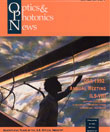
July 1992 Issue
Feature Articles
Multiple-Access Protocols for High-Speed Networks
Optical fibers have the potential to carry tens and even hundreds of Gbits/sec of information. The question of how to share these large capacities between many users through an efficient, flexible, and low cost network is a challenge. Standards are now being proposed that will decide the protocol for what might be called the third generation of local area and metropolitan area networks. This article explores the principal classes of protocols that permit efficient sharing of high-speed channels.
by John O. LimbInternational Standards for Ophthalmic Optics
The readers of this column regularly learn of progress in the development of international optical standards. The emphasis has been on fundamental optical standards and standards relating to purely optical devices and instruments, as these are the areas of interest to most. But over the last decade, there has been an extremely active standardization effort in the field of ophthalmic optics, which combines elements of traditional optics with visual science and eyecare. Scientifically, medically, and commercially, this has always been a very important area in optics. Today, with the economic unification of Europe taking place and the globalization of world markets, it has taken on particular significance.
by Charles CampbellSugar Water Mirage
The thin blanket of air that envelopes the Earth is rarefied at high altitudes and densifies with proximity to the surface. Thus the refractive index of the atmosphere increases in a continuous manner from unity in the vacuum of space to approximately n=1.000293 at sea level (λ=0.5893 μm). Everywhere the gradient of the refractive index points toward the Earth's center, and so light passing from the sun to an observer on Earth will take straight or curved paths depending on whether the light travels parallel or perpendicular to the index gradient. At high noon, the direct sunlight observed from the ground travels through the atmosphere along a straight trajectory. Direct sunlight reaching us at sunrise or sunset has taken a curved path, bending toward the high refractive index layers near the ground.
by Susan Houde-Walter, Greg PierceMuseum Competition Entry Goes on the Road
Do you want to help the public learn about optics? Entering OSA's Science Museum Competition may be your ticket. One of last year's entries is now part of a major traveling exhibit about the brain. Developed by a team at the Franklin Institute Science Museum, the exhibit, "It's all in your head," opened for its first three-month installment in Philadelphia in mid-June. After Philadelphia, the exhibit will tour many major U.S. cities, including Minneapolis-St. Paul, Boston, Chicago, and Los Angeles.
by Michael G. Littman
![Infinity Mirrored Room– Brilliance of the Souls 2014 by artist Yayoi Kusama. [© YAYOI KUSAMA]](https://opnmedia.blob.core.windows.net/$web/opn/media/images/articles/2024/0724/departments/202407-cover-web.jpg?ext=.jpg)
![An experimental scheme demonstrated by researchers at Princeton and Yale universities, USA, can convert physical noise into errors that can be corrected more easily. [F. Wojciechowski, Princeton University]](https://opnmedia.blob.core.windows.net/$web/opn/media/images/articles/2024/0624/departments/202406-cover-web.jpg?ext=.jpg)
